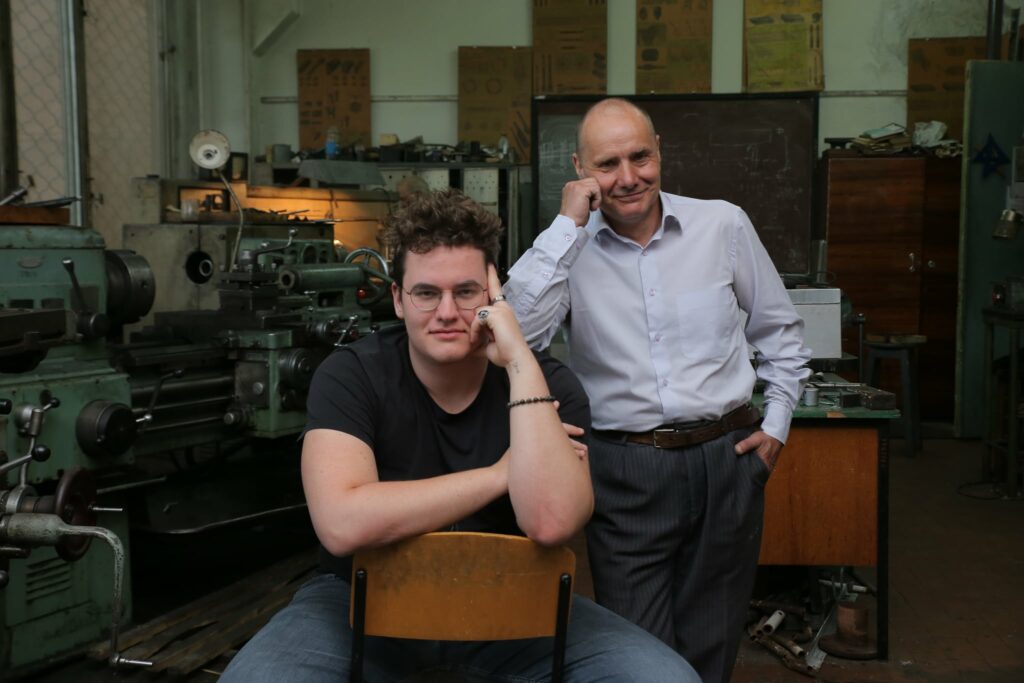Ukrainian designers design the smallest orbital rocket vehicle in history
Ukrainian startup Promin Aerospace creates a unique orbital rocket vehicle that will usher in the “democratic space” era. The founders of the startup want to make the launch of satellites available to both small corporations and research institutions.
One of the co-founders of the company is Misha Rudominsky (this is how he presents himself to Ukrainian and foreign investors, as he believes that the short name is also a brand), a startup school graduate at the Igor Sikorsky KPI.

We asked him: what will this rocket vehicle be like, what innovations are in the design? And who will benefit from the new space transport?
– In 2016, you became a finalist in the Sikorsky Challenge startup competition. What has this school given you? What idea did you present at the competition?
– I wanted to create a device that will help you quickly find a lost or stolen gadget. I went to classes at the startup school every night and at the same time studied at the Kyiv Natural Science Lyceum № 145. And although the device itself was not built (I found that it is not economically viable), but the knowledge gained at school was a real discovery for me. I learned to build a business model, attract investors, present my idea.
This was the first structured information about how does the world I live in work. I also found friends and like-minded people.
– How did the idea to build a rocket vehicle come about?
– I was interested in space since school, I was involved in the astronomy study group at the Center for Scientific and Technical Creativity “Sphere”. By the way, it was a very good level, Anatoliy Tugay, an associate professor of the Department of Astronomy and Space Physics at the Taras Shevchenko National University of Kyiv, taught there. I took part in competitions of research works of the Junior Academy of Sciences of Ukraine (and won!).
But for a long time I classified space research and projects as a field where only outstanding scientists and designers (of the Pivdenne Design Bureau level!) can work. I thought that I still had to dedicate half my life to “grow”.
And then I met a professor at Oles Honchar Dnipro National University, engineer, genius-inventor Vitaliy Yemets. Vitaliy spoke about the prospects of nanosatellites, that there was a huge need for small rocket vehicles that would launch these satellites into orbit. He was sure that the building of such a rocket vehicle is a realistic task. We discussed all aspects of such a startup for almost a year and finally decided to co-found the company. Today Vitaliy Yemets is the co-founder and technical director of Promin Aerospace.

– Please, tell us in more detail, what rocket vehicle are you building? For what tasks is it intended?
– It will be an ultralight missile weighing 100 to 500 kilograms.
Today, large or medium-range rocket vehicles launch satellites into orbit. If a company or research institution needs to launch a small satellite (of a few kilograms), it must “join” a rocket bus that launches dozens or hundreds of satellites at once. This satellite will be launched into orbit at the time and place where this “bus” starts.
Today we can see a huge imbalance: the demand for the launch of small satellites grows rapidly, but small or ultralight missiles for such a launch do not exist. So, we decided to give companies the opportunity to launch satellites into space, into orbit and at the time that they need.
– In your opinion, why has no one built such a rocket vehicle yet?
– There are several reasons. First, there was no nanosatellite market (the demand for such devices is forming right now). The first nanosatellite was launched in 2001; for all “zero” years (from 2000 to 2010) mankind launched only 99 such satellites. And more than seven hundred were launched in 2021!
Today, the smallest rocket vehicle is the American Astra. But it is twenty times bigger and more expensive than the rocket vehicle we build. Of course, the space industry is not at a stop, according to our estimates, today more than a hundred small-scale launchers are “in operation”.
Twelve missiles are being actively built today; others are being developed. Most of these missiles are planned to be launched by 2026.
By the way, I’m surprised that the space industry is often managed by very “inflexible” people. They think it’s right to launch big rocket vehicles and big satellites. During international conferences, I talk to these experts, explaining that there is a demand for launch vehicles for nanosatellites, that this market rapidly grows. In response, I often hear: “Oh, nonsense.” Of course, the space rocket market today includes big rocket vehicles, but in a couple of years we will be short of big rockets as well.
– What advantages will your rocket vehicle have in the space technology market? What innovations do you use in the design?
– It will be an autophagy rocket vehicle (that is, one that “eats” itself). We want to create a rocket using polymer fuel (both tanks and body), this will ensure low cost. During the flight, the fuel will burn, the rocket will decrease in mass. Other advantages include ease of fabrication and safety.
This rocket vehicle can be so small that it will deliver one satellite into orbit per launch. To date, we have conducted eight experiments and want to conduct two more of them in December. We burn fuel, test engine operation, record parameters and sensor readings, analyze statistics.
By the end of the year, we expect to receive full confirmation of our calculations for engine operation.
Sometimes I hear arguments: “why do you reinvent a bicycle”, you can just build a classic rocket vehicle, but smaller. Unfortunately, classic missiles cannot be “reduced” in mass. They have a so-called passive mass: fuel tanks, missile body, sediments, etc. It is economically unprofitable to build a traditional rocket vehicle weighing less than three tons.
– Where are the tests held, where and when do you plan to launch the rocket vehicle?
– The test stand with the engine is in the laboratory in the city of Dnipro. After testing, we will begin to build a suborbital rocket. The first model of the rocket vehicle will also be built in Dnipro. Ideally, we want to create a hybrid model, a part of it will be built in Ukraine, and the other part – at the launch site.
The best of all would be to launch a rocket vehicle from the equator or from the northern regions – Norway, Scotland. The best way to survey the Earth’s surface is from the polar orbit, these images can be useful for soil analysis, assessment of soil fertility, for defense purposes, etc.
We are looking for places to launch, we want to build one closer to the equator, and the other – closer to the North Pole. We have already held negotiations with experts from Scotland and Portugal. In Scotland they plan to build several space ports, and rocket builders are interested in cooperating. In the near future we want to go and see what conditions are offered there.
We want to launch our rocket vehicle into space in 2024-2025.
– Space and rockets are associated with billions in funding. And what about money in your case?
– We found an investor and attracted $ 500,000 in investment. Our investor is the Venture Fund QPDigital, which began to operate in December 2020. The budget of this fund is 100 million dollars, they invest in startups in the sphere of IT logistics, digital healthcare, game development, artificial intelligence, etc.
In the context of investment (especially venture investment), you never know how much you will need for the whole project. But you can calculate the amount needed to achieve a significant breakthrough. A significant breakthrough for us is a test stand with a running engine. This engine is 95 percent ready.
We need about $ 50 million to bring the case to the first successful launch. This is not much, because our rocket is small and one launch will cost many times cheaper compared with launches of our competitors.
– The Promin Aerospace website says that the advantage of your rocket vehicle is that it will not leave space debris. How can this be achieved?
– Garbage in space is a huge problem, especially when space countries shoot down their satellites (as Russia has recently done, “creating” several thousand fragments).
Satellites that are in low orbits (200 – 300 kilometers), usually after a few years loose hight and burn in the atmosphere. Those that circle higher (at an altitude of 500-600 kilometers), work 8 to 15 years. That is, today hundreds of satellites and millions of wreckage fly in different orbits at different speeds. And this is really a problem – at some moment humanity may run out of space in orbit.
When hundreds and thousands of small satellites are launched, this could create the preconditions for accidents on “space routes”. Therefore, the plans of the world space industry are to oblige operators to remove satellites from orbit after their use. Satellites must either burn in the atmosphere or rise very high where no one will be disturbed.
The problem with nanosatellites is that their owners do not always have finances for making a technical decision on their removal from the orbit. That is, if the satellite weighs three kilograms, and part of this weight is that of the structure and fuel for such procedure, then the space will not remain “on board” the satellite for necessary devices.
The uniqueness of our rocket vehicle is that approximately 95 percent of the work on launching into orbit is performed by its first stage. We want to place electronics for removing the satellite out of the orbit in the second stage. That is, during takeoff, the greater part of our rocket will burn, and the second stage will help remove the satellite out of the orbit upon completion of its mission. After launching the rocket and upon the mission completion, we will leave nothing in orbit. This is a significant advantage of our development!
– Recently, representatives of your company spoke at the International Space Congress in Dubai. What did you (or company representatives) tell the world space community about?
– Vitaliy Yemets spoke at the section “Solid and hybrid engines”, he told about the technical aspect of the project and test operations, in particular, about the latest studies of heat fluxes in the gasification chamber of the autophagy launch vehicle
Participation in such forums is very important. This is an opportunity to contact developers from other countries, exchange views, hear comments.
Many experts in the space industry are interested in our research. However, there were those who said: “No, this is impossible.” Well, that doesn’t stop us, we move on and do what we planned.
– Imagine that you and your team worked hard and succeeded. And what will happen “after the dot”? How do you see the launch day?
– The launch day will be perfect. I hope that after this launch there will be no “dots”, only “commas”.
The rocket is the basis for future exploration of the Earth’s surface and interplanetary missions. We do not plan to stop; the rocket launch is only a small part of our vision of the company’s development.
We are already working on other topics and projects.
Today there are fourteen people in our team. These are engineers, inventors, people who have experience in public and private space structures. These are real professionals who are absolutely sure that we certainly will succeed in it all and the rocket vehicle will fly.

– Are you sure of success? Will it fly?
– Yes, absolutely. If anyone can make such a rocket, it’s us. I am also convinced that Ukraine can become a leader in the development of space rocket vehicles that will launch nanosatellites into orbit.
Svitlana GALATA had this conversation
Svit newspaper, № 45-46, December 2021
